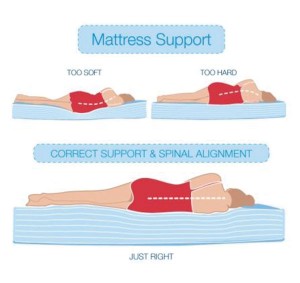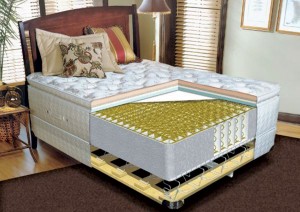Is it Time for a New Mattress?
Fact # 1
- Humans need to sleep about 30% of their lives – cats almost 50% and giraffes less than 10%!
Fact #2
- Humans are the only species who purposely delay sleep.
Fact #3
- More than 60% of North Americans do not experience a good night`s sleep
Fact #4
- Most of us are sleeping on a mattress long after it has lost its ability to provide our body with the comfort and support it needs for rest and regeneration.
Okay, I admit there are no statistics to back up number 4, but I think you will agree that sleeping well is of prime importance in allowing us to enjoy life and feel well, and a comfortable mattress and a clear mind are key factors.
I am not a sleep therapist, but I do know a thing or two about mattresses. If you are sleeping on one that is 7 to 10 years old it probably needs replacing. Do you wake up with stiffness, numbness or aches and pains? Do you sleep better somewhere other than on your own bed, such as a hotel or friend’s guest room? These are all indications that it’s time for a change.
Whilst asleep, each person on average moves sixty to seventy times a night – with a dozen or more full turns. Considering a third of your life is spent on yourmattress it is certainly important to have one that is comfortable, and that will help you get the sleep and rest your body needs.
Scary facts:
- The 1989 Exxon Valdez oil spill in Alaska, the Challenger space shuttle disaster and the Chernobyl nuclear accident have all been attributed to human errors in which sleep deprivation played a role.
- The NRMA estimates fatigue is involved in 1 in 6 fatal road accidents.
 Shopping for a new mattress is not quite as much fun as shopping for a new TV, plus we don`t have the selection here that we would back home, unfortunately not even in San Jose – but, choosing a suitable mattress is not exactly rocket science! Think about how you sleep; on your side, back or stomach, and you are half-way there.** The padded top layers will give added comfort and the spring core provides the support you need. Other than that, think about if you want innerspring or foam options, and then the price. All but the cheapest range of mattresses will be probably be fine for most people.
Shopping for a new mattress is not quite as much fun as shopping for a new TV, plus we don`t have the selection here that we would back home, unfortunately not even in San Jose – but, choosing a suitable mattress is not exactly rocket science! Think about how you sleep; on your side, back or stomach, and you are half-way there.** The padded top layers will give added comfort and the spring core provides the support you need. Other than that, think about if you want innerspring or foam options, and then the price. All but the cheapest range of mattresses will be probably be fine for most people.
However, I would usually suggest getting the best mattress you can afford. Typically, we spend more time lying on our mattress, than in front of our TV…! A less expensive mattresses will not last as long naturally, and you may start feeling the coils through thinner padding, or notice sags and lumps developing after a just few years, along with backache and stiff joints.
Generally, when choosing a new mattress, the 5 main factors to consider are:
Comfort: Pillow top, coil count, more firm or more plush?
Support: In which position do you usually sleep? Do you have back issues? Consider your weight and height.
Price: Set a realistic budget. Will a new bed include a new mattress?
Type: Innerspring or foam (memory foam, latex, or regular foam)?
Durability: Reliable brand? Coil count? Guarantee?
Size matters – back home we are used to standardized sizes. Every King, Queen or Twin mattress will fit the equivalent size bed. Not so here… Check carefully before you buy.
Comfort is highly subjective, and complicated by the fact that possibly two people will be sharing the same mattress. If possible test them out first. Experts suggest 15 to 20 minutes in different sleeping positions. Make sure you both have enough room. If one partner is very active at night it may well disturb the other – opt for a larger bed when possible. King beds offer the best of both worlds – each sleeper can use a twin (individual) mattress for their specific requirements and comfort preferences.
Some interesting mattress tips that you may also want to consider in your deliberations:-
- Memory Foam: Developed by NASA (like many other great things) and adapted for commercial use. It softens and conforms to the sleeper in response to body heat and weight. It can relieve pressure on painful joints but, as with all synthetic foam mattresses, will feel warmer than a regular, innerspring one.
- Latex foam (not synthetic latex) is one of the best and lets the body breathe naturally while offering decent support, and is not as hot as other foam because it is natural.
- Firmer Mattresses are recommended for all stomach and some back sleepers. Softer mattresses are better for side sleepers, and medium mattresses are recommended for most back sleepers.
- Higher coil count usually means longer life and more support – which is not the same as firmness.
- Considering the humidity factor here, do not buy a mattress that has been sitting around in the store for ages. Order a new one.
- When you buy a new mattress, get new pillows.
- Vacuum it regularly to protect it from mold and bugs.
- Mattresses last longer if they are turned and rotated regularly – every 3 months. (NB.Every two weeks for the 1st 6 months)
- Use a washable mattress protector to prolong the life of your mattress, and wash it often.
- Never sit on the edge of a mattress.
Pillows and sheets are other components in that ideal sleeping environment. Lumpy or musty smelling pillows have to go. Allergies will have you snuffling or snoring all night, and who can sleep well with an uncomfortable pillow? Choose a good, hypoallergenic pillow and wash it often. And with sheets, buy the best sheets you can afford.
“Life is too short to sleep on low thread-count sheets.” ~Leah Stussy.
Bamboo is one of the best fibres to keep you comfortable and cool, and as a bonus it also has natural properties that will not allow mold and bacteria to grow! Even in our rainy and damp winters, this amazing fibre keeps you feeling dry and comfortable! These sheets are not inexpensive – but I guarantee you will never regret buying them.
Sweet dreams!



